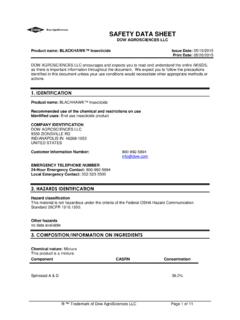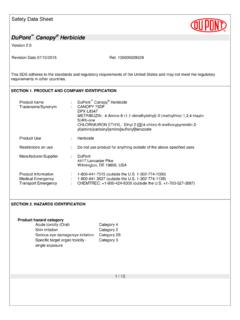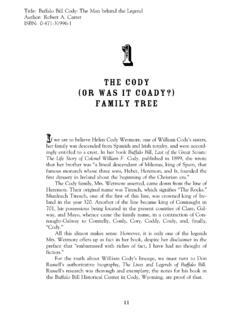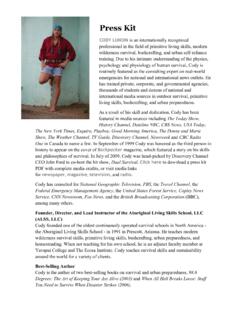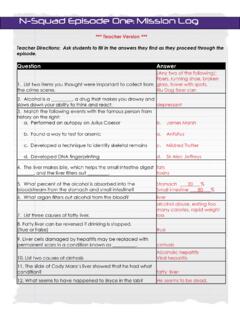Transcription of AG Prescott Specimen Label - Keystone Pest Solutions
1 1 CODY HERBICIDES pecimen LabelFor selective control of broadleaf weeds in wheat and barley not underseededwith a legume, corn, fallow cropland, grasses grown for seed, rangeland andpermanent grass pastures, conservation reserve program (CRP) acres andnon-croplandACTIVE INGREDIENTS:Clopyralid MEA salt: 3,6-dichloro-2-pyridinecarboxylicacid, monoethanolamine salt.. ,4-dichlorophenoxyacetic acid, triisopropanolamine salt* .. INGREDIENTS:.. :.. Equivalents: clopyralid: 3,6-dichloro-2-pyridinecarboxylic acid - - lb/gal 2,4-dichlorophenoxyacetic acid - - lb/gal*lsomer Specific by AOAC Method No. (15th Ed.)EPA Reg. No. 81927-28 EPA Est. No. 42750-MO-001 ALB; 37429-GA-001BT53883-TX-002 CSI; 81927-AL-001 PMLetter(s) in lot number correspond(s) to superscript in EPA Est. OUT OF REACH OF CHILDRENDANGER / PELIGROSi usted no entiende la etiqueta, busque a alguien para que se la explique a usted endetalle. (If you do not understand the Label , find someone to explain it to you in detail.)
2 Manufactured for: Alligare, LLC13 N. 8th StreetOpelika, AL 36801 PRECAUTIONARY STATEMENTSHAZARDS TO HUMANS AND DOMESTIC ANIMALSDANGER!Corrosive. Causes irreversible eye damage. Harmful if absorbed through skinor inhaled. Harmful if swallowed. Do not get in eyes, on skin, or on clothing. Wear protec-tive eyewear (goggles or face shield). Avoid breathing spray PROTECTIVE EQUIPMENT (PPE)Some materials that are chemical-resistant to this product are butyl rubber, natural rubber,neoprene or nitrile rubber. If you want more options, follow the instructions for Category Aon an EPA chemical-resistance category selection mixers, loaders, applicators, flaggers, and other handlers must wear: Long-sleeved shirt and long pants Chemical resistant gloves Shoes plus socks Protective eyewear Chemical-resistant apron when applying with any hand-held nozzle or equipment, mixingor loading, cleaning up spills or equipment, or otherwise exposed to the engineering controls for additional containers of over 1 gallon, but less than 5 gallons: Mixers and loaders who do not usea mechanical system (such as probe and pump) to transfer the contents of this containermust wear coveralls or a chemical-resistant apron in addition to other required clothing and other absorbent materials that have been drenched or heavily contam-inated with this product s concentrate.
3 Do not reuse them. Follow manufacturer s instructionsfor cleaning/maintaining PPE. If no such instructions for washables exist, use detergent andhot water. Keep and wash PPE separately from other laundry. After each day of use, cloth-ing or PPE must not be reused until it has been CONTROLS STATEMENTSP ilots must use an enclosed cockpit that meets the requirements listed in the WPS for agri-cultural pesticides [40 CFR (d)(6)].When handlers use enclosed cabs or aircraft in a manner that meets the requirements list-ed in the Worker Protection Standard (WPS) for agricultural pesticides [40 CFR (d)(4-6)], the handler PPE requirements may be reduced or modified as specified in the HAZARDSThis pesticide is toxic to fish and aquatic invertebrates. Do not apply directly to water, toareas where surface water is present or to intertidal areas below the mean high water not contaminate water when disposing of equipment washwaters or rinsate. Drift andrunoff may be hazardous to aquatic organisms in water adjacent to treated areas.
4 Apply thisproduct only as directed on chemical has properties and characteristics associated with chemicals detected ingroundwater. The use of this chemical in areas where soils are permeable, particularlywhere the water table is shallow, may result in groundwater contamination. Applicationaround a cistern or well may result in contamination of drinking water or is a chemical which can travel (seep or leach) through soil and under certain con-ditions contaminate groundwater which may be used for irrigation or drinking are advised not to apply clopyralid where soils have a rapid to very rapid permeabili-ty throughout the profile (such as loamy sand to sand) and the water table of an underlyingaquifer is shallow, or to soils that would allow direct introduction into an aquifer. Your localagricultural agencies can provide further information on the type of soil in your area and thelocation of Chemical: Do not ship or store with food, feeds, drugs or FOR USEIt is a violation of Federal law to use this product in a manner inconsistent with its all Directions for Use carefully before and use of this product in Suffolk and Nassau counties in the state of New Yorkis prohibited.
5 Use of this product in the state of New York is limited to postemergenceapplication with a maximum use of fl oz ( lb of clopyralid) per acre per year;and providing that no other product containing clopyralid has been applied pre-plantor of this product in Oregon is limited to the sites stated on this Label which are agri-cultural not apply this product in a way that will contact workers or other persons, either directly orthrough drift. Only protected handlers may be in the area during application. For any require-ments specific to your state or tribe, consult the agency responsible for pesticide AIDIf in eyes: Hold eye open and rinse slowly and gently with water for 15-20minutes. Remove contact lenses, if present, after the first 5 minutes, thencontinue rinsing eye. Call a poison control center or doctor for treatment on skin orclothing: Take off contaminated clothing. Rinse skin immediately with plenty of water for 15-20 minutes. Call a poison control center or doctor for treatment swallowed: Call a poison control center or doctor immediately for treatment advice.
6 Have person sip a glass of water if able to swallow. Do not induce vomiting unless told to do so by the poison controlcenter or doctor. Do not give anything by mouth to an unconscious inhaled: Move person to fresh air. If person is not breathing, call 911 or an ambulance, then giveartificial respiration, preferably by mouth-to-mouth, if possible. Call a poison control center or doctor for further treatment LINE NUMBERHave the product container or Label with you when calling a poison control center ordoctor, or going for treatment. You may also contact 1-800-424-9300 for emergencymedical treatment TO PHYSICIANP robable mucosal damage may contraindicate the use of gastric SAFETY RECOMMENDATIONSU sers should: Wash hands before eating, drinking, chewing gum, using tobacco, or using the toilet. Remove clothing/PPE immediately if pesticide gets inside. Then wash thoroughly andput on clean clothing. Remove PPE immediately after handling this product. Wash the outside of gloves beforeremoving.
7 As soon as possible, wash thoroughly and change into clean USE REQUIREMENTSUse this product only in accordance with its labeling and with the Worker ProtectionStandard, 40 CFR Part 170. This Standard contains requirements for the protection ofagricultural workers on farms, forests, nurseries, and greenhouses, and handlers of agri-cultural pesticides. It contains requirements for training, decontamination, notification,and emergency assistance. It also contains specific instructions and exceptions pertain-ing to the statements on this Label about personal protective equipment (PPE), andrestricted-entry interval. The requirements in this box only apply to uses of this productthat are covered by the Worker Protection not enter or allow worker entry into treated areas during the restricted entry interval(REI) of 48 required for early entry to treated areas that is permitted under the WorkerProtection Standard and that involves contact with anything that has been treated, suchas plants, soil, or water, is: Coveralls Chemical-resistant gloves made of any waterproof material Shoes plus socks Protective eyewearNON-AGRICULTURAL USE REQUIREMENTSThe requirements in this box apply to uses of this product that are NOT within the scopeof the Worker Protection Standard for pesticides (40 CFR Part 170).
8 The WPS applieswhen this product is used to produce agricultural plants on farms, forests, nurseries, Restrictions for Non-WPS Uses: For applications to fallow cropland, rangeland,pasture, and non-crop areas, do not enter or allow people (or pets) to enter the treatedareas until sprays have dried. For early entry to treated areas, wear eye protection,chemical-resistant gloves made of any waterproof material, long-sleeved shirt, longpants, shoes and HERBICIDES pecimen LabelPRODUCT INFORMATIONA lligare Cody Herbicide is recommended for selective, postemergence control of broadleafweeds in wheat and barley not underseeded with a legume, fallow cropland (including sum-mer fallow, post-harvest, and set-aside acres) rangeland and permanent grass pastures,land in the Conservation Reserve Program (CRP) and AND RESTRICTIONSUse of this product in Oregon is limited to the sites stated on this Label which are agricultur-al directions in Alligare, LLC supplemental labeling may supersede directions or limitationsin this not exceed a cumulative amount of lb active ingredient ( ) of clopyralid per acre( pts.)
9 Alligare Cody Herbicide/A) per single crop not contaminate irrigation ditches or water used for irrigation or domestic not use in : Do not apply this product through any type of irrigation forbs (desirable broadleaf forage plants) are susceptible to Alligare Cody Herbicide. Donot spray pastures containing desirable forbs, especially legumes, unless injury can be tol-erated. However, the stand and growth of established perennial grasses is usually improvedafter spraying, especially when rainfall is adequate and grazing is not use on newly seeded areas until grass is well established as indicated by vigorousgrowth and development of tillers and secondary not use on only once per crop cycle, except for grasses grown for seed (see specific use direc-tions). An application to fallow cropland preceding or following an application to small grains(wheat or barley) is Restrictions: Do not graze lactating dairy cattle in treated areas for14 days after application.
10 Remove meat animals from freshly treated areas 7 days beforeslaughter. Withdrawal is not needed if 2 weeks or more have elapsed since application. Donot cut treated grass for hay within 30 days after not transfer livestock from treated grazing areas (or feeding of treated hay) to sensitivebroadleaf crop areas without first allowing 7 days of grazing on an untreated pasture (orfeeding of treated hay). If livestock are transferred within 7 days of grazing untreated pasture or eating untreated hay,urine and manure may contain enough clopyralid to cause injury to sensitive Bioassay Instructions:In fields previously treated with this product, plant short testrows of the intended rotational crop across the original direction of application. The test areashould sample field conditions such as soil texture, soil pH, drainage, and any other variablethat could affect the seed bed of the new crop. The field bioassay can be initiated at any timebetween harvest of the treated crop and the planting of the rotational crop.








